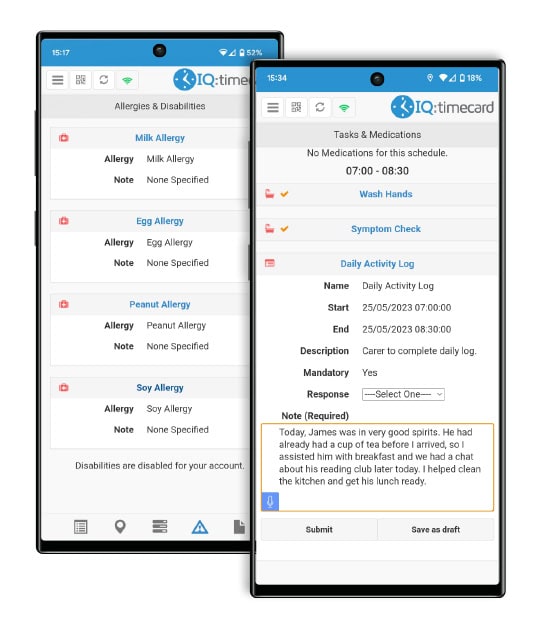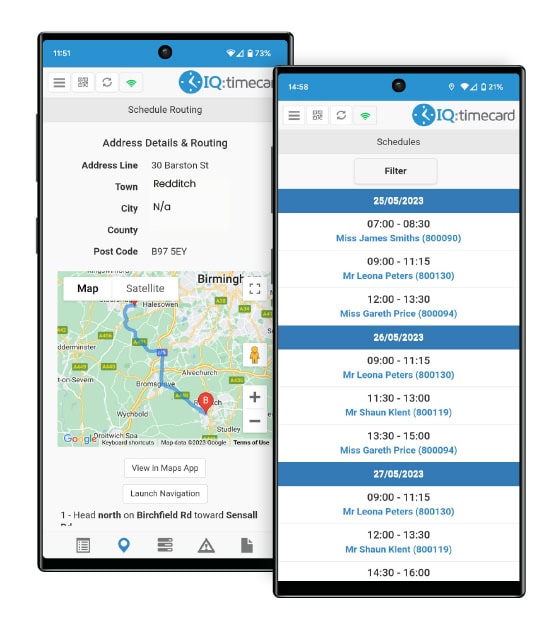
Improving carer job satisfaction by providing more time to care
A key component to delivering better carer job satisfaction is time. And with an ever-growing mountain of tasks and responsibilities to complete during visits, carers often find that ‘time’ is an asset they can ill-afford to lose.
Care management software replaces manual administration processes that clog up a carer’s day, freeing time to focus on clients.
Care professionals often choose to work in the sector because they genuinely care about looking after people. Spending more time with clients allows carers to focus on tasks they care about, leading to increased satisfaction and improved outcomes for both carers and clients.
How care management software can improve carer job satisfaction
Care management technology is used by more than just managers and office staff. Software like IQ:caremanger works in concert with a dedicated care app to assist remote care workers with their duties.
The care app can help improve job satisfaction in several ways. Firstly, by automating administrative tasks such as filling out client paperwork, creating schedules, and generating reports, carers have more time to spend with their clients, leading to a sense of fulfilment and accomplishment.
Secondly, care management software can help carers be more efficient, reducing stress and frustration associated with paperwork and administrative tasks. This can lead to a greater sense of control and autonomy over their work.
Finally, care management software can improve communication and collaboration among care teams, enabling carers to work more effectively with their colleagues and feel more supported in their roles. This can contribute to a sense of belonging and job satisfaction.
The crucial information carers need to provide outstanding care

The cornerstone of tech-enabled home care is the carer app. The app connects directly to the care office’s management software and provides carers with real-time updates on client information, schedules, and to-do lists, accessible via their smartphone.
Some of the most useful information carers can access include:
- Daily visit schedule
- Client locations
- Key safe codes
- Access arrangements
- Tasks to complete
- Medications to administer
- Care plans
- Visit notes
- Allergies and disabilities
By providing instant access to the information they need to perform their daily tasks, carers will spend less time pouring over paperwork, and more time providing active care.
Seeing a schedule in advance and route planning

Not knowing what tasks to perform each day can be unsettling. However, with care management software, carers can access their schedules through the app, providing clarity and reducing uncertainty. This can help carers see what they will be doing on any given day, who they will be visiting, and the time they have to get from one visit to the next.
By having instant access to this information carers will feel more comfortable with their daily schedule and have adequate time to prepare for the tasks and responsibilities they need to deliver.
Some of the most useful scheduling features include:
- Ability to see schedules in advance
- Integrated route planning via a preferred navigation app
- Push notifications when visits or schedules change
- SMS/email reminders to highlight the upcoming schedule
- Emailed timesheets -– formal spreadsheet showing all calls for the week ahead, which includes details of what needs to happen at a visit
Reducing the administrative burdens of care visits
Providing care services is a serious responsibility for all involved. Ensuring that care meets regulatory standards, health and safety requirements, risk assessments, and the needs of the individual cannot be overstated. And all of this must be documented.
While there isn’t a magic wand to replace every administrative process, care management technology can do some of the heavier lifting.
Paper forms such as visit notes, MAR sheets, task lists, risk assessments, care plans, mileage forms and clock-in sheets are replaced with digital forms or automated buttons within the carer app. This is further sped up by the innate functionality of app technology – namely Autocorrect, predictive text and voice-to-text speech recognition.
To-do lists are also digitised within the carer app – meaning carers can view the tasks they need to complete as a digital list and simply tick them off as they progress through the visit. Tasks can be set up in a huge variety of ways to suit the needs and requirements of each client. Some of the features include:
- Mandatory tasks that must be completed before a carer can clock out
- Optional tasks that can be carried out based on the needs of the client
- Instructions to assist with the delivery of the task
- Optional or mandatory notes, so that the carer can provide content and feedback about the task